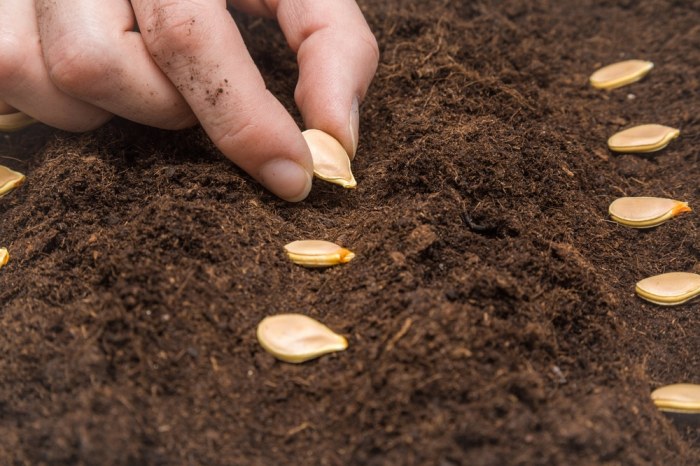Preparing the Soil for Pumpkin Seeds

When plant pumpkin seeds – Now that your pumpkin seeds are ready, let’s turn our attention to the crucial element that will nurture their growth: the soil. Providing your pumpkin plants with the perfect soil environment is akin to giving them a head start in the race to become plump, prize-winning gourds. The right soil will ensure strong roots, vigorous growth, and ultimately, a bountiful harvest.Preparing the soil isn’t just about digging a hole; it’s about creating a thriving ecosystem tailored to the needs of your pumpkin plants.
This involves understanding your soil’s current condition, making necessary amendments, and ensuring optimal drainage and aeration. Let’s delve into the details.
Soil Testing and Amendment Selection
Before you even think about planting, understanding your soil’s composition is paramount. A simple soil test, readily available at most garden centers or through your local agricultural extension office, will reveal your soil’s pH level, nutrient content, and texture. This information is your roadmap to success. For instance, a soil test might indicate a deficiency in nitrogen, phosphorus, or potassium – essential nutrients for robust pumpkin growth.
So, you’re wondering when to plant pumpkin seeds? Generally, after the last frost is a good rule of thumb. Thinking about other fruit trees though? Choosing the right spot is key, and if you’re considering a pomegranate, check out this guide on where to plant a pomegranate tree for some helpful tips. Getting back to pumpkins, remember soil temperature is also a factor for successful germination.
Based on the test results, you can select appropriate amendments. For example, adding compost will improve soil structure, increase organic matter, and boost nutrient levels. Similarly, adding lime will raise the pH if it’s too acidic, while sulfur will lower it if it’s too alkaline. Remember, pumpkins thrive in slightly acidic to neutral soil, ideally with a pH between 6.0 and 6.8.
A soil test provides the precise data needed to tailor your amendment strategy.
Soil Types and Suitability for Pumpkins
Pumpkins are adaptable, but they prefer well-drained soil. Sandy loam is generally ideal because it offers excellent drainage and aeration, preventing waterlogging which can lead to root rot. Clay soils, on the other hand, tend to retain too much water and can become compacted, hindering root development. If you have clay soil, incorporating significant amounts of organic matter like compost or well-rotted manure will improve its drainage and structure.
Silty soils offer a good balance but may need amendments to enhance drainage depending on their composition. Ultimately, the goal is to create a soil that is loose, fertile, and well-aerated – a perfect environment for your pumpkin’s roots to explore and flourish.
Creating Raised Beds or Amending Existing Soil
For optimal drainage and aeration, particularly in heavy clay soils, raised beds are a fantastic solution. Raised beds allow for better control over soil composition and drainage. Constructing a raised bed is relatively straightforward: Simply build a box using wood, bricks, or other suitable materials, fill it with a well-draining soil mix (a blend of topsoil, compost, and perhaps some perlite or vermiculite for improved drainage), and you’ve created a haven for your pumpkins.
Alternatively, if you’re working with existing soil, focus on improving its structure by adding generous amounts of organic matter. Till the amendments thoroughly into the soil to a depth of at least 12 inches, ensuring even distribution. This process significantly enhances drainage and aeration, creating a much more hospitable environment for your pumpkin seedlings. Remember, good soil preparation is the foundation for a successful pumpkin harvest – a reward well worth the effort.
Pumpkin Seed Germination and Early Growth: When Plant Pumpkin Seeds

Witnessing the miracle of a tiny pumpkin seed transforming into a vibrant seedling is incredibly rewarding! Understanding the conditions that foster this transformation is key to a bountiful harvest. By providing the perfect environment, you’ll give your pumpkins the best possible start.The journey from seed to seedling hinges on three crucial elements: temperature, moisture, and light. Optimal germination typically occurs when soil temperatures reach between 65-95°F (18-35°C).
Think of it like this: just as we need a comfortable temperature to thrive, so do these little pumpkin seeds. Consistent moisture is equally vital; the soil should be damp but not waterlogged. Imagine a well-wrung-out sponge – that’s the perfect level of moisture. While pumpkin seeds don’t require light to germinate, adequate sunlight is crucial for healthy seedling growth once they emerge.
Factors Affecting Germination
Improper planting depth can significantly impact germination rates. Planting seeds too deep can prevent them from accessing the necessary oxygen and light, while planting them too shallow exposes them to drying out and damage. Similarly, insufficient watering can hinder germination. A lack of moisture prevents the seed from absorbing water, a process essential for initiating the germination process. Conversely, overwatering can lead to rot and fungal diseases, killing the seed before it even has a chance to sprout.
Think of it like Goldilocks and the Three Bears – we need to find that ‘just right’ balance.
Common Pumpkin Seedling Problems
Understanding potential problems and their solutions is crucial for success. The following table provides insights into common issues, their causes, and effective solutions.
| Problem | Cause | Solution |
|---|---|---|
| Seed rot | Overwatering, poor drainage, fungal diseases | Ensure proper drainage, avoid overwatering, use seed-starting mix with good drainage, and consider a fungicide treatment. |
| Seedling damping-off | Fungal pathogens in damp soil, poor air circulation | Use sterilized soil, improve air circulation, avoid overhead watering, and apply a fungicide if necessary. |
| Slow or no germination | Improper planting depth, low soil temperature, insufficient moisture | Plant seeds at the correct depth (usually 1-2 inches), maintain optimal soil temperature, and ensure consistent moisture. |
| Weak seedlings | Insufficient light, nutrient deficiencies | Provide adequate sunlight or supplemental light, use a balanced fertilizer formulated for seedlings. |
| Leggy seedlings | Insufficient light | Provide more light, either by moving seedlings closer to a light source or using grow lights. |
Pumpkin Seed Variety Selection and Considerations

Choosing the right pumpkin seeds is the cornerstone of a bountiful harvest. The sheer variety available can be overwhelming, but understanding a few key characteristics will help you select the perfect pumpkins for your garden and your culinary desires. This section will guide you through the exciting world of pumpkin seed varieties, helping you make informed choices that guarantee success.
Pumpkin Variety Categorization
Selecting the appropriate pumpkin variety hinges on understanding their diverse characteristics. These differences are significant and influence everything from the size of your final pumpkin to its ideal growing conditions and even its taste. Consider these key factors when making your selection.
- Size: Pumpkins range dramatically in size, from petite varieties ideal for pies to giant pumpkins suitable for carving competitions. Miniature pumpkins, like ‘Jack Be Little’, typically weigh less than a pound, while Atlantic Giant pumpkins can reach hundreds of pounds.
- Growth Habit: Some pumpkins are bush-type, meaning they grow compactly, while others are vining, sprawling across the ground. Bush varieties are excellent for smaller gardens, whereas vining varieties need more space to spread. ‘Baby Boo’ is a compact bush variety, while ‘Howden Biggie’ is a vigorous vine.
- Ideal Growing Conditions: Different pumpkin varieties have different tolerances for temperature, sunlight, and soil conditions. Some thrive in hot, sunny climates, while others prefer cooler temperatures. Consider your local climate and soil type when choosing a variety. For example, ‘Connecticut Field’ thrives in cooler climates, while ‘Fairytale’ prefers warmer temperatures.
Pumpkin Variety Characteristics and Uses, When plant pumpkin seeds
Beyond size and growth habit, pumpkin varieties possess unique characteristics that influence their ultimate use.
- Taste and Texture: Some pumpkins are known for their sweet, flavorful flesh, perfect for pies and other desserts. Others have a drier, denser flesh better suited for soups or purees. ‘Sugar Pie’ is prized for its intensely sweet flavor, while ‘Cinderella’ offers a firmer texture ideal for carving.
- Intended Use: Pumpkins are incredibly versatile. Some are specifically bred for carving, boasting sturdy rinds and attractive shapes. Others excel in the kitchen, offering delicious flesh for pies, soups, or even roasting. ‘Howden Biggie’, as mentioned before, is a large carving pumpkin, while ‘Rouge Vif d’Etampes’ is a classic culinary pumpkin.
Climate and Growing Condition Considerations
Choosing a pumpkin variety that thrives in your specific climate is crucial for success. Ignoring this aspect can lead to poor growth, smaller pumpkins, or even complete failure.
Consider your region’s average temperatures, sunlight hours, and typical rainfall. Research the specific requirements of the varieties you are considering to ensure a good match. For instance, if you live in a region with short growing seasons, you’ll want to select an early-maturing variety. Conversely, if you have a long, warm growing season, you might opt for a larger, later-maturing variety.
Always check the seed packet or online resources for detailed information on the ideal growing conditions for your chosen pumpkin variety.
Question & Answer Hub
How deep should I plant pumpkin seeds?
Plant pumpkin seeds about 1-2 inches deep.
How far apart should I space pumpkin plants?
Space pumpkin plants 4-6 feet apart to allow for ample growth.
What should I do if my pumpkin seedlings are wilting?
Check for overwatering or underwatering. Ensure proper drainage and adjust watering accordingly.
Can I save seeds from my pumpkins to plant next year?
Yes, but be sure to select seeds from healthy, mature pumpkins of the variety you wish to grow again.




